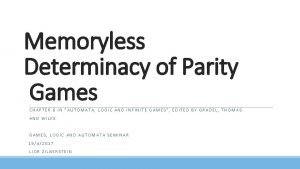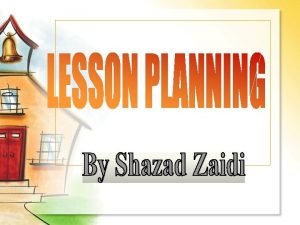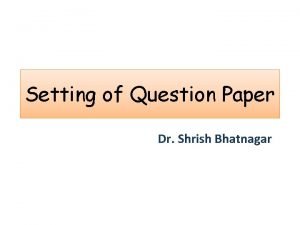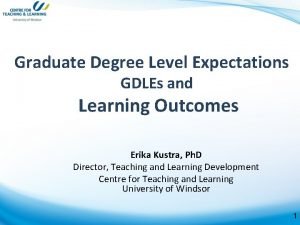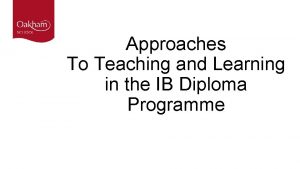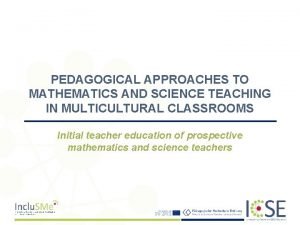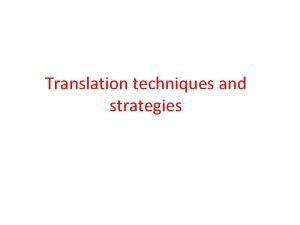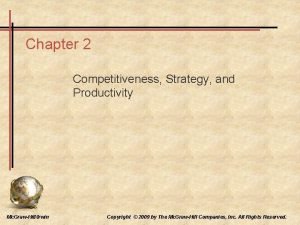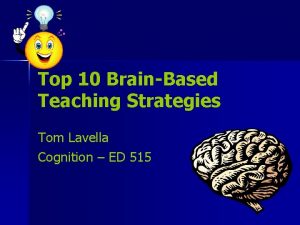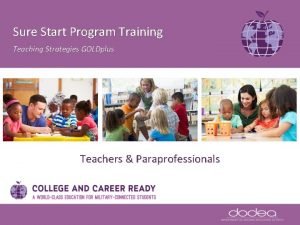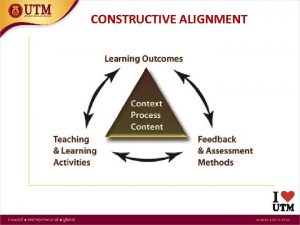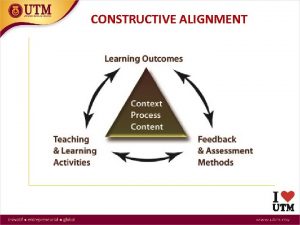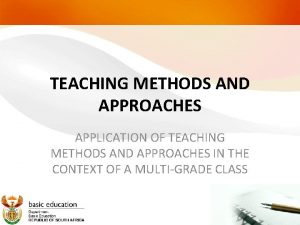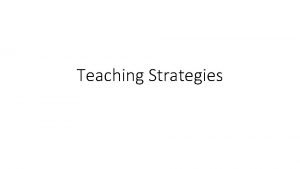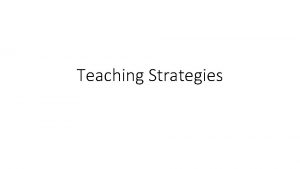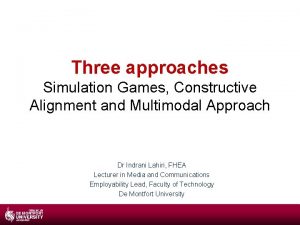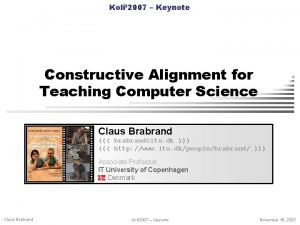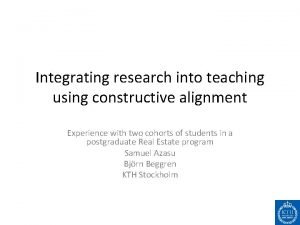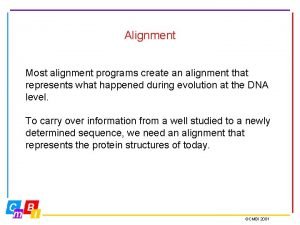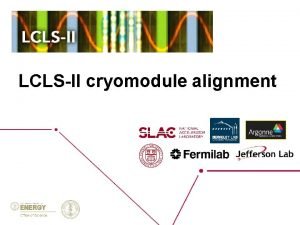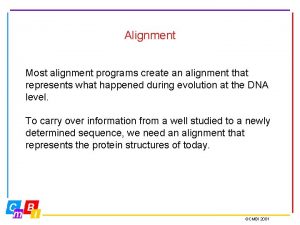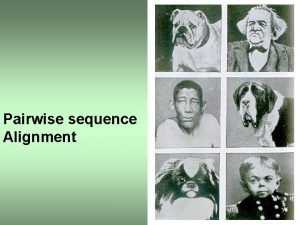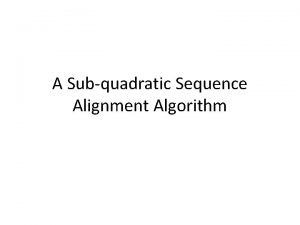CONSTRUCTIVE ALIGNMENT CONSTRUCTIVE ALIGNMENT TEACHING APPROACHES STRATEGIES METHODS



![Student-Centered Instruction [SCI] • is an instructional approach in which students influence the content, Student-Centered Instruction [SCI] • is an instructional approach in which students influence the content,](https://slidetodoc.com/presentation_image_h/071850cd1c53e18d0fc668ad1e855770/image-4.jpg)
![Student-Centered Instruction [SCI] • The SCI approach includes assigning open-ended problems and problems requiring Student-Centered Instruction [SCI] • The SCI approach includes assigning open-ended problems and problems requiring](https://slidetodoc.com/presentation_image_h/071850cd1c53e18d0fc668ad1e855770/image-5.jpg)















- Slides: 20

CONSTRUCTIVE ALIGNMENT

CONSTRUCTIVE ALIGNMENT

TEACHING APPROACHES, STRATEGIES, METHODS, ACTIVITIES ‘A THOUSAND TEACHERS A THOUSAND METHODS’ CHINESE PROVERB
![StudentCentered Instruction SCI is an instructional approach in which students influence the content Student-Centered Instruction [SCI] • is an instructional approach in which students influence the content,](https://slidetodoc.com/presentation_image_h/071850cd1c53e18d0fc668ad1e855770/image-4.jpg)
Student-Centered Instruction [SCI] • is an instructional approach in which students influence the content, activities, materials, and pace of learning. • This learning model places the student (learner) in the center of the learning process. • The instructor provides students with opportunities to learn independently and from one another and coaches them in the skills they need to do so effectively.
![StudentCentered Instruction SCI The SCI approach includes assigning openended problems and problems requiring Student-Centered Instruction [SCI] • The SCI approach includes assigning open-ended problems and problems requiring](https://slidetodoc.com/presentation_image_h/071850cd1c53e18d0fc668ad1e855770/image-5.jpg)
Student-Centered Instruction [SCI] • The SCI approach includes assigning open-ended problems and problems requiring critical or creative thinking that cannot be solved by following text examples, involving students in simulations and role plays, and using self-paced and/or cooperative (teambased) learning. Properly implemented SCI can lead to increased motivation to learn, greater retention of knowledge, deeper understanding, and more positive attitudes towards the subject being taught (Collins & O'Brien, 2003).

TEACHING AND LEARNING APPROACHES, STRATEGIES, METHODS, ACTIVITIES Lecturer-Centered Students are viewed as “empty The teacher’s primary role is to coach vessels” whose primary role is and facilitate student learning and to passively receive overall comprehension of material information • Lecture • Direct Instruction • Demonstration Refers to the traditional teaching strategy that relies on explicit teaching through lectures and teacher-led demonstrations Teachers /Lecturers are the sole supplier of knowledge and information. These methods are effective in teaching basic and fundamental skills across all Group Discussion § Buzz Group § Symposium Discussion § Debate Discussion § Phillips 66 § Think Pair Share § Picture Making § Round Robin § 3 -Steps Interview § Jigsaw Cooperative Learning refers to a method of teaching and classroom management that emphasizes group work and a strong sense of community.

TEACHING AND LEARNING APPROACHES, STRATEGIES, METHODS, ACTIVITIES Lecturer-Centered Student-Centered Inquiry Based Learning (Inductive Teaching & Learning) A teaching method that focuses on student investigation and hands-on learning. In this method, the teacher’s primary role is that of a facilitator, providing guidance and support for students through the learning process. • Case-Based Learning -CBL • Problem-Based Learning - PBL • Project-Based Learning - Pj. BL • Senario-Based Learning – SBL • Discovery Learning • Experiential Learning

Lecture • Students concentration during presentations often declines after 15 minutes. • Break for : – – – A Think Pair Share activities Buzz Group 3 step interview Phillips 66 A concept test

Group Discussion Factors Affecting Group Discussion • • • Size of the group Cliques Within a Group Personal Goals of Members: Physical Environment Seating Arrangement Time for Discussion

Group Discussion Six attributes of effective small group activities : • • • Interesting topic Clearly defined Sequenced Well paced Flexible Participative

Group Discussion Preparing A Group Discussion • Choose A Topic: A topic for group discussion should be interesting, significant, and manageable. • Decide What Type of Question to Discuss: Topic chosen should be worded in the form of a question. • Word the Question Carefully: Once the question is formed, then narrow it down by wording it in clear, concise, and unbiased language. • Prepare an Outline: To keep the group moving toward its goal. • Research A Topic: All members doing research on the topic before the discussion takes place

Buzz Group • A buzz group is a small group, consisting of three to six people who are given an assignment to complete in a short time period. Generally, each buzz group records their output then reports to the larger group. Can be used : • Build an agenda. • Serve as an icebreaker • Solve problems • Share ideas • Generate lists. • Reflect and review. Evaluate an activity or process. Warm up a group to a new topic. Address a topic from a new perspective. Generate ideas Gather feedback

Think Pair Share • Pose the problem and have students work on it individually for a short time • Then have them form pairs and reconcile and improve their solutions • and finally call on several individuals or pairs to share their responses. Note : This structure takes a bit more time than a simple group activity, but it includes individual thinking and so leads to greater learning.

Symposium Discussion • A discussion in which the topic is broken its various phases. • Each part is presented by an expert / person well informed on their particular phase in a brief and consice speech [The group consist of 3 -4 members, discuss and plan the outline] • Audience direct questions to proper symposium members • The leader summarizes

Phillips 66 • • It’s a spontaneous method Where 6 students view their opinions on a topic For 6 minutes Randomly call any students to share their ideas / solutions

Picture Making • A technique to stimulate interest, thinking, and participation by – selecting a question/ statement / problem on the topic which suitable to illustrate – Instruction must be clear – Adequate materials – chart paper, markers • How ? ? ? • Lecturers divides the group into 4 -5 sub-groups • Each sub-groups is given a question/ statement / problem to illustrate • After complete the picture making, each group shows and explains the picture followed by class discussion

ROUND ROBIN • Class is divided into small groups (4 to 6) with one person appointed as the recorder. • A question is posed and students are given time to think about answers. • After the "think time, " members of the team share responses with one another round robin style • The recorder writes down the answers of the group members. • The person next to the recorder starts and each person in the group in order gives an answer until time is called.

THREE-STEP INTERVIEW • Each member of a team chooses another member to be a partner • First round, an individuals interview their partners by asking clarifying questions. • During the second round, partners reverse the roles • For the final round, members share their partner's response with the team.


 Constructive proof vs non constructive
Constructive proof vs non constructive Constructive proof vs non constructive
Constructive proof vs non constructive Constructive proof vs non constructive
Constructive proof vs non constructive Proof by contradiction example
Proof by contradiction example Image alignment
Image alignment Importance of educational planning
Importance of educational planning Constructive alignment
Constructive alignment Constructive alignment
Constructive alignment Compare two sequences
Compare two sequences Pam1250
Pam1250 Global alignment vs local alignment
Global alignment vs local alignment Alignment in bioinformatics
Alignment in bioinformatics Global vs local alignment
Global vs local alignment Characteristics of direct instruction
Characteristics of direct instruction Ib approaches to teaching and learning
Ib approaches to teaching and learning Pedagogical approaches to teaching math
Pedagogical approaches to teaching math Translation loss
Translation loss The methods and actions taken to accomplish strategies
The methods and actions taken to accomplish strategies Direct wax pattern technique
Direct wax pattern technique Top 10 brain-based teaching strategies
Top 10 brain-based teaching strategies Teaching strategies gold training
Teaching strategies gold training

